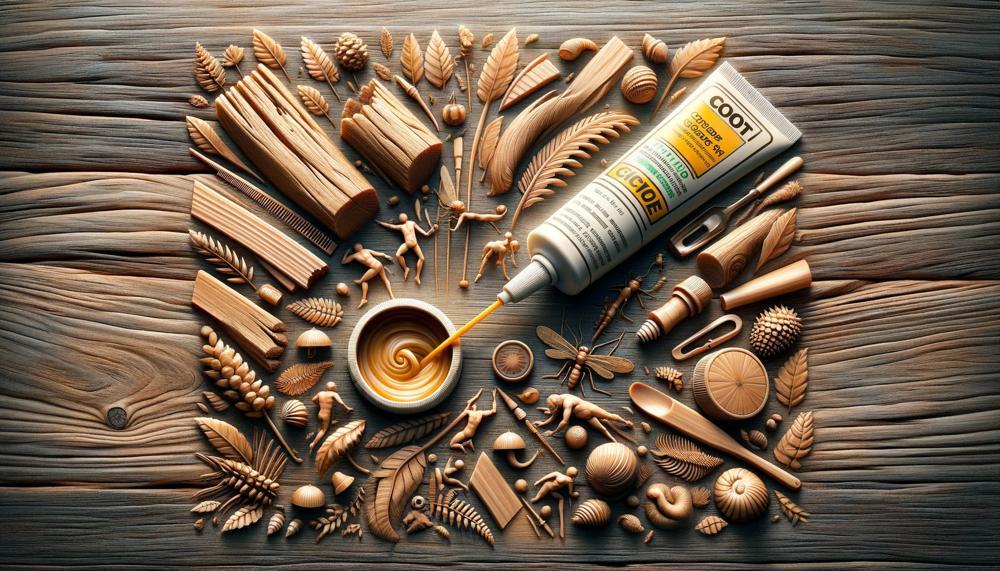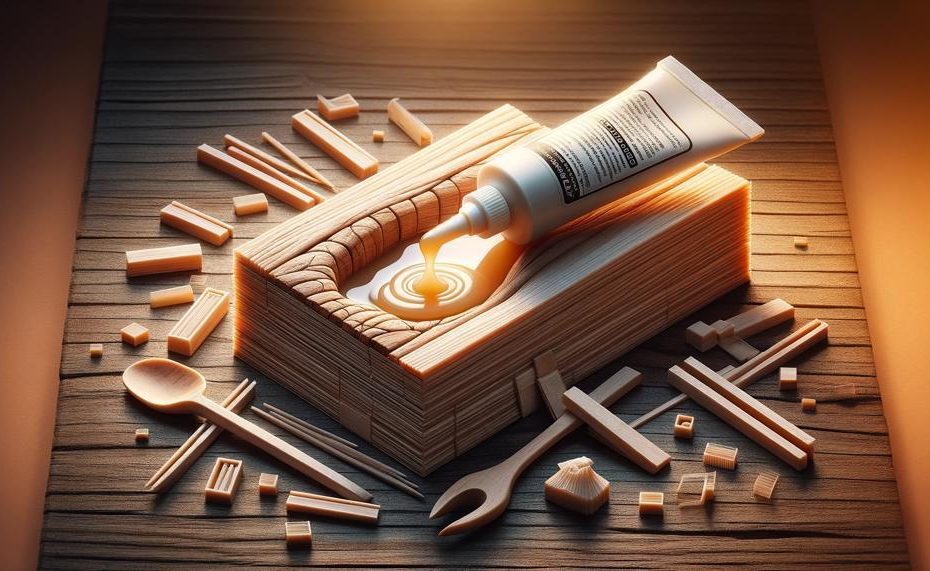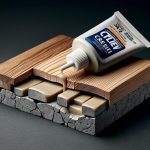In the ever-evolving world of woodworking and craft, finding innovative and effective methods to protect and enhance our projects is always a priority. One technique that stands out for its simplicity and effectiveness is using glue to seal wood. This method not only offers a protective layer against moisture and wear but also provides a smooth, finishing touch that can elevate the appearance of your woodwork. In today’s article, we’re diving deep into the nuances of this approach, uncovering how a simple adhesive can become a woodworker’s best ally.
So, can I use glue to seal wood?
Yes, you can use glue to seal wood. Some people use wood glue to seal blanks, such as burl wood, before stabilizing it. Others use glue to seal MDF with water and denatured alcohol.
PVA glue can reduce the porosity of wood, but it’s water soluble and doesn’t offer much protection. Better general purpose sealers include polyurethane, lacquer, shellac, linseed oil, and tung oil.
Film forming wood finishes only slow down water vapor transfer, but they don’t stop it. All wood finishes will fail over time, and some may not seal the wood at all.
Whether you’re a seasoned craftsman or a weekend DIY enthusiast, understanding the potential of glue in sealing wood can transform the way you approach your projects. Get ready to enhance your woodworking game with practical insights and expert advice tailored to elevate your crafting journey.
Table of Contents
- 1 Types of Glue for Sealing Wood
- 2 Advantages and Disadvantages of Using Glue to Seal Wood
- 3 How to Choose the Right Glue for Your Project
- 4 Preparing the Wood Before Applying Glue
- 5 Applying Glue as a Sealant
- 6 Curing Time for Glued Surfaces
- 7 Tips and Tricks for Working with Glue
- 8 Special Considerations When Using Glue to Seal Wood
- 9 Conclusion
Types of Glue for Sealing Wood
Understanding the various types of glue for sealing wood is crucial for any woodworking project. Here’s a breakdown of the main types, their properties, and applications:
| Type of Glue | Properties | Uses |
| Polyvinyl Acetate (PVA) | Non-water-resistant, strong bond, dries clear. | Ideal for indoor wood projects where moisture isn’t a concern. |
| Polyurethane | Water-resistant, versatile, expands while curing. | Perfect for outdoor projects or areas exposed to moisture. |
| Hide Glue | Reversible with heat, natural, traditional. | Best for antique furniture or where reversibility is needed. |
| Epoxy | Two-part adhesive, gap-filling, quick-hardening. | Suitable for outdoor use, high-stress areas, and gap filling. |
| Cyanoacrylate (CA) | Fast-drying, strong bond, not water-resistant. | Good for quick repairs, small projects, or temporary bonds. |
Choosing the right glue depends on the project’s specifics – whether it’s indoor or outdoor, the need for water resistance, and the type of wood. For instance, PVA glue is your go-to for indoor furniture, while polyurethane is a champ for garden benches exposed to rain.
If you’re fixing a cherished heirloom, hide glue’s your mate, given its reversibility. Epoxy shines when you need to fill those pesky gaps or bond uneven surfaces, and for those quick fixes or tiny jobs, CA glue steps up to the plate.
Advantages and Disadvantages of Using Glue to Seal Wood
| Advantages | Disadvantages |
|
|
Sealing wood with glue is like inviting a steadfast friend and a finicky critic into your workshop. Its strong bonding power and ease of use make it a go-to for anyone looking to create lasting wooden crafts.
Yet, its demands for speed, pressure, and the right conditions remind us that even the best tools have their quirks.
How to Choose the Right Glue for Your Project
To determine the most suitable type of glue for sealing wood in your project, you need to weigh several factors like the wood type, the environmental conditions it’ll face, and the specific demands of your project.
| Type of Glue | Key Features | Best For |
| Polyurethane Glue | Water-resistant, versatile, expands while curing | Outdoor projects, various wood types, gap-filling |
| Epoxy Resin | Highly durable, waterproof, can fill gaps | Outdoor use, high-stress joints, repairing |
| PVA (Polyvinyl Acetate) | Easy to use, dries clear, non-toxic | Indoor projects, fine woodworking, crafts |
| Cyanoacrylate (Super Glue) | Fast-drying, strong bond, clear finish | Small repairs, delicate woodwork, quick fixes |
| Hide Glue | Traditional, reversible, natural | Antique restoration, musical instruments, fine woodworking |
Before selecting your glue, consider the project’s exposure to moisture or weather conditions. If it’s an outdoor piece or likely to encounter water, opt for waterproof options like epoxy or polyurethane glue. For indoor projects, PVA might suffice, but it isn’t the best choice for sealing against moisture.
Prep your wood surfaces properly by sanding and cleaning them to ensure a strong adhesive bond. Always follow the manufacturer’s application instructions for the best results.
Remember, safety first: use gloves and work in a well-ventilated area when handling glues with strong fumes.
Preparing the Wood Before Applying Glue
To ensure your woodworking projects are as sturdy as they are splendid, giving the timber a proper prep before you introduce any adhesive is key. Here’s how to lay the groundwork for a bond that’s not just durable but downright unyielding.
- Wipe Away the World: Begin by banishing any dust, grease, or ghostly residues from your wood. A clean, dry cloth or a puff of compressed air should do the trick. It’s not just about cleanliness; it’s about ensuring nothing comes between your wood and a flawless glue-up.
- Sanding Makes Perfect: Arm yourself with sandpaper and smooth down your timber. This step isn’t just about aesthetics; it’s about creating a level playing field for the glue. Plus, it opens up the wood’s pores, making it more receptive to your adhesive’s embrace.
- Condition to Perfection: Some woods are finicky and might soak up the glue like a parched sponge, weakening your bond. Applying a wood conditioner is like giving your wood a pep talk, ensuring it plays nice with the glue.
- Clamp Down on Your Craft: Bringing in clamps isn’t just about keeping the wood in place; it’s about applying consistent pressure to foster a strong bond as the glue dries. Think of it as the wood getting cozy and deciding to stick together for the long haul.
- Patience is a Virtue: Rushing the drying process is like pulling a cake out of the oven too early. It might look ready, but the inside tells another story. Give it time—generally 24 hours—to ensure the bond sets solidly.
Applying Glue as a Sealant
Glue, often perceived merely as an adhesive for bonding wood pieces, can indeed double as an effective sealant for wood projects. The trick lies in selecting the appropriate type of glue and applying it meticulously to seal wood against moisture and environmental damage.
Types of Wood Glue Suitable as Sealants
- Epoxy Glue: Renowned for its strength and durability, epoxy glue stands out as the champion for outdoor projects or any woodwork exposed to moisture. Its resilience makes it a top contender for sealing purposes.
- Polyurethane Glue: This versatile adhesive is not just for bonding; it’s perfect for sealing wood, offering maximum durability and excellent water resistance, ideal for outdoor furniture or wooden boats.
- Cyanoacrylate Glue: For quick fixes or small-scale projects, cyanoacrylate (superglue) can provide a fast-drying seal. However, its use as a sealant might be limited by its lesser resistance to water over time.
Applying Glue as a Sealant – A Step-by-Step Guide
| Step | Action | Tips |
| Select the Right Glue | Choose epoxy or polyurethane glue for the best sealing effect. | Consider the wood’s exposure to elements. |
| Surface Preparation | Clean and sand the wood surface. | Ensures better adhesion and penetration. |
| Apply the Glue | Use a brush or roller to apply thinly and evenly. | Multiple thin layers are superior to one thick layer. |
| Let it Dry | Allow each layer to dry completely before adding another. | Patience is key for a durable seal. |
| Test the Seal | After drying, check the seal’s strength and integrity. | Ensures long-lasting protection against moisture. |
Curing Time for Glued Surfaces
Curing time for glued surfaces is a crucial factor in determining the effectiveness of using glue to seal wood. It’s the span needed for the glue to achieve its full strength, directly impacting the bond’s durability and the woodwork’s overall integrity.
This period can vary based on the glue type, ambient temperature, and humidity levels. Here’s how curing time affects the glue’s performance in wood sealing:
- Initial Grab vs. Full Cure: Initially, glue might seem to hold the wood pieces together tightly, but it hasn’t reached its maximum strength until it fully cures. This distinction is vital for projects requiring high durability.
- Temperature Sensitivity: As highlighted in the research, cold weather can significantly slow down the curing process. This slowdown not only extends the time before the wood can be handled or stressed but may also result in a weaker bond if the glue doesn’t cure properly.
- Optimal Conditions for Strength: For a glue bond to develop its full strength, curing must occur under ideal conditions. Even slightly lower temperatures than recommended can decrease the bond’s strength, impacting the project’s longevity and resilience.
- Climate-Controlled Environments: To mitigate temperature effects, working in a climate-controlled environment ensures the glue cures within the ideal time frame, thus maintaining its bonding effectiveness.
Here’s a simplified table showing how different conditions affect the curing time and the resultant bond strength:
| Condition | Effect on Curing Time | Impact on Bond Strength |
| Optimal Temperature | Standard Curing Time | Highest Strength |
| Cold Temperature | Extended Curing Time | Reduced Strength |
| Extremely Cold Temperature | Potentially Ineffective Curing | Weak or Brittle Bond |
Understanding these dynamics ensures that when sealing wood with glue, one can plan around environmental factors to avoid compromised bonds.
Tips and Tricks for Working with Glue
To achieve a strong and durable seal when using glue to bond wood, follow these tailored tips and practices:
Select the Right Type of Glue:
- PVA Glue: Ideal for indoor projects, offers ease of use, and is affordable.
- Epoxy Glue: Best for stronger bonds, suitable for outdoor or high-stress areas.
- Polyurethane Glue: Provides versatility and durability, great for outdoor projects.
Surface Preparation:

- Clean: Ensure surfaces are free from dust, oil, or wax.
- Dry: Remove any moisture for better adhesion.
- Roughen: Lightly sand surfaces to enhance glue grip.
Application Technique:
- Even Application: Use a brush or roller for uniform coverage.
- Adequate Amount: Apply sufficient glue to avoid weak joints.
- Avoid Excess: Too much glue can weaken the bond.
Clamping and Curing:
- Firm Pressure: Use clamps to apply consistent pressure until the glue sets.
- Time: Allow ample curing time as recommended by the glue manufacturer.
- Environment: Maintain optimal temperature and humidity levels.
Considerations Based on Wood Type:
- Hardwoods: May require stronger glues like epoxy.
- Softwoods: Typically bond well with PVA or polyurethane glues.
Post-Bonding Care:
- Inspect: Check for any gaps or weak spots.
- Test: Gently stress-test the bond after curing.
Special Considerations When Using Glue to Seal Wood
When sealing wood with glue, different timbers and scenarios need tailored approaches. Understanding these can transform your project from good to exceptional.
Best Types of Wood for Glue Sealing:
Some woods are more accepting of glue-based sealing than others. Typically, softer woods like pine or spruce are easier to work with since their porous nature allows for better absorption and adhesion.
However, this doesn’t mean you should shun hardwoods; just prepare them a tad more meticulously.
| Wood Type | Preparation Needed | Glue Type Recommended |
| Softwood (Pine, Spruce) | Sanding to 120-150 grit | PVA, Polyurethane |
| Hardwood (Oak, Walnut) | Sanding to 220 grit, clean thoroughly | Epoxy, Polyurethane |
| Exterior Wood | Thorough cleaning, drying | Polyurethane, Epoxy (weather-resistant) |
Remember, while PVA glue is a chap’s go-to for indoor projects, it’s a tad shy around water. For garden benches or outdoor frames, reach instead for the sturdier polyurethane or epoxy — these chaps don’t flinch at a splash or two.
Conclusion
Using glue as a sealer in woodworking is an artistic endeavor that involves a delicate dance between the substance and the craftsman. This technique goes beyond conventional applications, providing protection from moisture and abrasion while guaranteeing the longevity of your products.
Our exploration of the adhesive world shows a diverse range of personalities, from the sturdy polyurethane that is best for outside toughness to the traditional PVA that is great for indoor beauty.
Every kind has a purpose, catered to the various requirements of woodworkers, whether they are building a piece of heirloom quality or taking on a project in their garden.
It’s critical to comprehend how to strike a balance between adhesive strength, water resistance, and the particular requirements of each sort of wood. Sanding and preparing your wood properly guarantees that it is not just ready but also eager for the transformational power of glue. By using this information, woodworkers may turn basic objects into enduring masterpieces.
This is a plea to look below the sticky surface of glue and see its potential as a wood conservator and enhancer, more than just a useful guide. If you use the appropriate kind, apply it carefully, and allow it time to cure, your projects will not only survive but also thrive.






